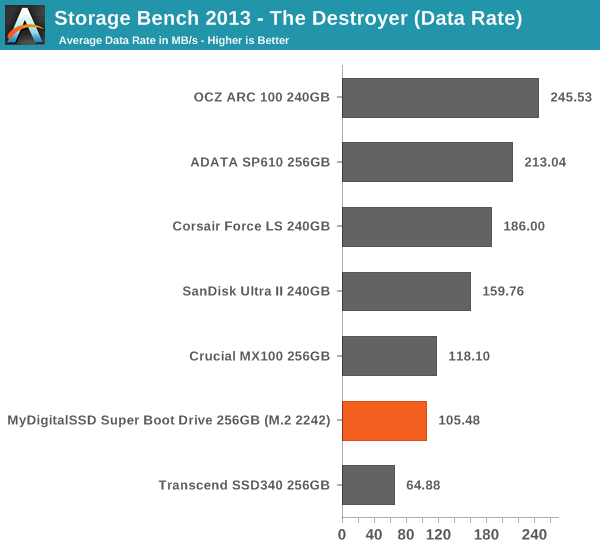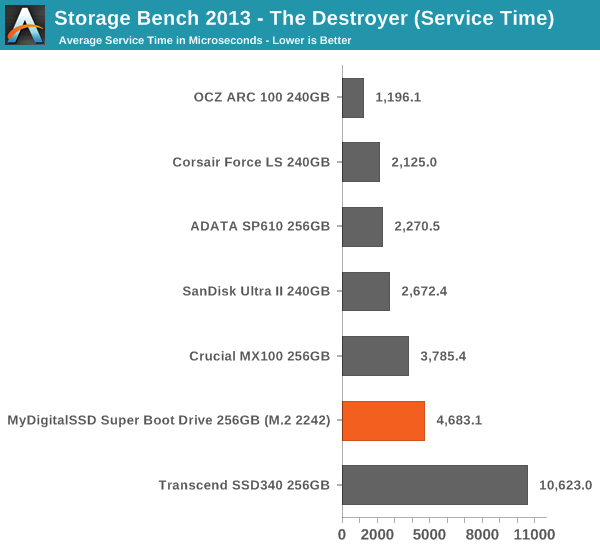Upgrading the SSD in Chromebook & MyDigitalSSD Super Boot Drive M.2 2242 SSD Review
by Kristian Vättö on October 21, 2014 8:00 AM ESTAnandTech Storage Bench 2013
Our Storage Bench 2013 focuses on worst-case multitasking and IO consistency. Similar to our earlier Storage Benches, the test is still application trace based – we record all IO requests made to a test system and play them back on the drive we are testing and run statistical analysis on the drive's responses. There are 49.8 million IO operations in total with 1583.0GB of reads and 875.6GB of writes. I'm not including the full description of the test for better readability, so make sure to read our Storage Bench 2013 introduction for the full details.
| AnandTech Storage Bench 2013 - The Destroyer | ||
| Workload | Description | Applications Used |
| Photo Sync/Editing | Import images, edit, export | Adobe Photoshop CS6, Adobe Lightroom 4, Dropbox |
| Gaming | Download/install games, play games | Steam, Deus Ex, Skyrim, StarCraft 2, BioShock Infinite |
| Virtualization | Run/manage VM, use general apps inside VM | VirtualBox |
| General Productivity | Browse the web, manage local email, copy files, encrypt/decrypt files, backup system, download content, virus/malware scan | Chrome, IE10, Outlook, Windows 8, AxCrypt, uTorrent, Ad-Aware |
| Video Playback | Copy and watch movies | Windows 8 |
| Application Development | Compile projects, check out code, download code samples | Visual Studio 2012 |
We are reporting two primary metrics with the Destroyer: average data rate in MB/s and average service time in microseconds. The former gives you an idea of the throughput of the drive during the time that it was running the test workload. This can be a very good indication of overall performance. What average data rate doesn't do a good job of is taking into account response time of very bursty (read: high queue depth) IO. By reporting average service time we heavily weigh latency for queued IOs. You'll note that this is a metric we have been reporting in our enterprise benchmarks for a while now. With the client tests maturing, the time was right for a little convergence.

The Super Boot Drive actually does surprisingly well in our 2013 suite given that it is an M.2 2242 design while the other SSDs in the comparison are 2.5". The M.2 2242 form factor does not allow for a separate DRAM cache and limits the drive to just two channels, leaving half the channels unpopulated and thus reducing maximum performance.











67 Comments
View All Comments
abianand - Thursday, October 23, 2014 - link
Thank you...very stupid of me posing a question without reading the article fully. First time I've done that.Spending around 75-80 for an ssd upgrade negatively affects the value proposition of the chromebook, which in the first place is questionable (to my purpose)
AnnonymousCoward - Thursday, October 23, 2014 - link
5 pages talk about performance, yet there's no inkling on actual user performance. You say "the performance difference is tremendous" - back that up with boot time or app launch time! Just looking at synthetics is idiotic.Realtime power consumption is less meaningful than total power consumed for some task. Faster transfer rates use more power while it's transferring but operate for less time.
cutterjohn - Saturday, November 1, 2014 - link
Also remember AMD is AWFUL wrt power usage.I recently bought a C720/i3/4GB version and replaced the shipped SSD w/128GB my digital -> ~100GB available. I suspect that part of the SSD space is walled of for OS reasons as there is a factory restore(in Android parlance) option which means a clean copy is stored somewhere, probably on it's own partition, and part of the space is probably also saved as misc space(I forget what they call it for SSDs, spare?).
Anyways ATM I've also croutonized it w/ xfce/Ubuntu 14.04, there's also croagh which supports more distros, e.g. ARCH, and chrubuntu which just replaces chrome os IIRC(wasn't ready to do that and probably won't*.)
* I used chrome os exclusively for a few days(waiting for SSD delivery) and it was quite fast and power efficient, regularly giving me ~8h of runtime. It was able to play netflix & amazon instant video OOB, but I haven't tried again since dev moding it and croutonizing it. (I've seen comments that dev mode removes netflix streaming capability, but they were old.)
Even with chroot Ubuntu/xfce it's pretty quick. A fair number of steam games are available for it, and I've just recently installed wine, but have not gotten around to trying out and windows apps/games yet although there are some videos of even skyrim(low settings although the videographer claims medium does OK as well) running on a celery chromebook.
Personally, I'd like an even smaller chromebook, more in the original netbook form factor, in which case 1280x720 or the existing 1366x768 would be quite dense although cramping the keyboard. I mainly picked it up for size and batt runtime as even my Sager 7330 is a bit bulky at times(13") and batt runtime is usually only ~3h. I also wouldn't have minded an i5 option as well and slotted RAM...
omegajimes - Tuesday, November 4, 2014 - link
Do people actually use Chromebooks with ChromeOS? I thought the only reason to pick these up were to load lightweight linux distros like Mint or Elementary on them.leoku - Wednesday, November 5, 2014 - link
I think the Commodore C64 all-in-one in the great grandpa's era is more fun than these netbooks and chromebooks, plus you can program it right out of the box. A Commodore C64 is more expensive than Chromebook nowadays, though.leoku - Wednesday, November 5, 2014 - link
Given the fact, I think the SSD upgrade for a Chromebook is a waste of money.dareo - Sunday, November 30, 2014 - link
I’ve just ordered a Lenovo S540 and it comes with a 1 TB HDD (5400 rpm) + a 16 GB M.2 SSD for caching. This leads to several questions related to the MyDigitalSSD 128GB Super Boot Drive:1. Could I swap out the 16 GB M.2 that comes with the Lenovo, replace it with the MyDigitalSSD 128GB Super Boot Drive, install the OS and apps on it and use it as the primary boot drive?
2. What’s the difference between the MyDigitalSSD 128GB Super Boot Drive and the MyDigitalSSD SC2 Super Cache 2 42mm SATA III 6G M.2 NGFF M2 SSD Solid State Drive?
3. How reliable is this M.2 SSD in comparison to a Crucial MX100 or a Samsung EVO?
4. Would it just make more sense to pluck the M.2 and HHD from the computer and install a 500 GB Crucial MX100 or a Samsung EVO?
Thanks in advance for any feedback / advice on this.